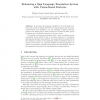27 search results - page 4 / 6 » Product-HMMs for automatic sign language recognition |
HCI
2001
13 years 7 months ago
2001
: For the past two years we have been addressing the challenges involved in managing the data generated within immersive environments. We together with many other researchers have ...
ICPR
2006
IEEE
14 years 6 months ago
2006
IEEE
Coarticulation is one of the important factors that makes automatic sign language recognition a hard problem. Unlike in speech recognition, coarticulation effects in sign language...
CVPR
2009
IEEE
14 years 11 months ago
2009
IEEE
This paper introduces a fully-automated, unsupervised method to recognise sign from subtitles. It does this by using data mining to align correspondences in sections of videos. Bas...
FGR
2008
IEEE
14 years 7 days ago
2008
IEEE
In this paper, we investigate the mutual-complementary functionality of accelerometer (ACC) and electromyogram (EMG) for recognizing seven word-level sign vocabularies in German S...
GW
2007
Springer
13 years 12 months ago
2007
Springer
Abstract. In automatic sign language translation, one of the main problems is the usage of spatial information in sign language and its proper representation and translation, e.g. ...

